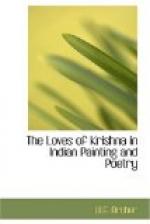Note 17, p. 73.
During the eleventh and twelfth centuries, a parallel situation seems to have arisen in feudal France and Germany where local love-poetry also treated adultery as a sine qua non of romance.
’Two things prevented the men of that age from connecting their ideal of romantic and passionate love with marriage. The first is, of course, the actual practice of feudal society. Marriages had nothing to do with love and no ‘nonsense’ about marriage was tolerated. All marriages were matches of interest and, worse still, of an interest that was continually changing. When the alliance which had answered would answer no longer, the husband’s object was to get rid of the lady as quickly as possible. Marriages were frequently dissolved. The same woman who was the lady and ‘the dearest dread’ of her vassals was often little better than a piece of property to her husband. He was master in his own house. So far from being a natural channel for the new kind of love, marriage was rather the drab background against which that love stood out in all the contrast of its new tenderness and delicacy. The situation is indeed a very simple one, and not peculiar to the Middle Ages. Any idealization of sexual love, in a society where marriage is purely utilitarian, must begin by being an idealization of adultery.’ (C.S. Lewis, The Allegory of Love (London, 1936), 13.)
Note 18, p. 77.
Much of the Gita Govinda’s power arises from the endowment of Nature with romantic ardour, the forest itself being presented as a highly sensitive and symbolic setting for the behaviour of lovers. The following passage from Tess of the D’Urbervilles is perhaps the nearest approach in English to this kind of treatment.
’Amid the oozing fatness and warm ferments of the Var Vale, at a season when the rush of juices could almost be heard below the hiss of fertilization, it was impossible that the most fanciful love should not grow passionate. The ready bosoms existing there were impregnated by their surroundings. July passed over their heads and the weather which came in its wake seemed an effort on the part of Nature to match the state of hearts at Talbothays Dairy. The air of the place, so fresh in the spring and early summer, was stagnant and enervating now. Its heavy scents weighed upon them, and at mid-day the landscape seemed lying in a swoon. Ethiopic scorchings browned the upper slopes of the pastures, but there was still bright herbage here where the water courses purled. And as Clare was oppressed by the outward heats, so was he burdened inwardly by waxing fervour of passion for the soft and silent Tess.’
Note 19, p. 77.
The Gita Govinda was one of the first Sanskrit poems to be rendered into English—Sir William Jones publishing a mellifluous version in Asiatick Researches in 1792. Later in the nineteenth century it was translated into Victorian verse by Sir Edwin Arnold. The present translation from which all the extracts are taken is by George Keyt, the foremost modern artist of Ceylon. It is greatly to be hoped that the entire translation, hitherto available only in an Indian edition, will one day be published in England.




